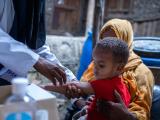May 14, 2003 (CIDRAP News) – In new guidelines for obtaining federal bioterrorism preparedness funds, the Department of Health and Human Services (HHS) is urging states to press on with their smallpox vaccination efforts and other smallpox response planning.
The guidelines, announced May 9, call on states to continue vaccinating and training public health and healthcare workers for smallpox response teams. The guidelines also advise states to extend the immunization and training to other health workers and to law enforcement and emergency workers as soon as they are ready.
The vaccination program was launched in January with the aim of quickly vaccinating more than 400,000 health workers for the smallpox response teams, but only 35,903 people had been vaccinated as of May 2, according to the Centers for Disease Control and Prevention (CDC).
The HHS guidelines advise states, territories, and major cities on how to qualify for close to $1.4 billion in fiscal year 2003 grants for bioterrorism and public health preparedness funds. The money includes $870 million for health departments and $498 million for hospitals. The CDC is administering the public health funds, while the Health Resources and Services Administration (HRSA) handles the hospital funds; each agency has its own set of guidelines.
"We listened to our state and local partners and are providing more comprehensive guidelines for this year's awards," Jerome Hauer, acting assistant secretary for public health emergency preparedness, said in a news release announcing the guidelines.
Two weeks ago, Congress's General Accounting Office (GAO) called on the CDC to advise the states on how to adjust their smallpox preparedness efforts in view of the slow progress of the vaccination program. The report urged the CDC to help the states revise their targets for the first round of vaccinations—the smallpox response teams—and guide them in moving on to the second round, aimed at additional health workers plus emergency workers. In a letter accompanying the GAO report, CDC Director Julie Gerberding said the forthcoming guidelines for the fiscal year 2003 bioterrorism funding would provide the information the states need to complete their vaccination programs.
The CDC's guidelines are called "Continuation Guidance for Cooperative Agreement on Public Health Preparedness and Response for Bioterrorism—Budget Year Four." A section dealing with smallpox calls for an "increased focus on all the elements needed to assure acceptable levels of preparedness." The instructions continue, "In accordance with grantees' 'Pre-Event Response Plans,' the focus of this cooperative agreement workplan should remain on preparation of those individuals and teams who would be essential to creating an effective level of preparedness for a smallpox outbreak response."
The guidelines further say that public health response teams "must be large enough to initiate population-based vaccination programs" on short notice, because a smallpox outbreak anywhere in the world would spark public demand for smallpox shots.
States should expand their immunization and training efforts beyond the response teams if they "feel they are in a position" to do so, the instructions state. The expansion should focus on four groups:
- Police and other security workers who, in case of an outbreak, would keep order at smallpox vaccination clinics and enforce public health interventions to contain the outbreak
- Emergency medical services (EMS) workers who would be called on to transport smallpox patients to hospitals
- Hospital workers who could have direct contact with smallpox patients
- Outpatient healthcare providers who could encounter patients seeking care
The guidelines do not suggest specifically how many people should be vaccinated in either phase of the smallpox immunization program. Original plans for the second phase called for vaccinating up to 10 million health workers and first responders, but HHS officials more recently have said that 2 million might be sufficient.
The Association of State and Territorial Health Officials (ASTHO), like the GAO, has said that states need more guidance for their smallpox preparedness programs. The organization has not yet had time to evaluate to what extent the new HHS guidelines answer the questions of state health officials, ASTHO Communication Director Paula Steib told CIDRAP News today.
HHS officials said the CDC guidelines are grouped in seven categories: preparedness planning and readiness assessment, surveillance and epidemiology, laboratory capacity for handling biologic agents, lab capacity for chemical agents, Health Alert Network and information technology, communication of health risks and other health information, and education and training. Activities related to smallpox preparedness are included in all of these areas, the agency said.
The HRSA (hospital) guidelines include six priority areas: governance, regional surge capacity to handle terrorism victims, emergency medical services, hospital linkages to health departments, education and preparedness training, and terrorism preparedness exercises.
Hauer said HHS is emphasizing the "coordination and blending" of the CDC-funded and HRSA-funded efforts by asking states to integrate their public health and hospital preparedness programs.
States have until July 1 to submit their application for the federal funds, according to the guidelines. The money provided is intended to be used between Aug 31, 2003, and Aug 30, 2004.
See also:
HHS news release
http://archive.hhs.gov/news/press/2003pres/20030509.html
CDC guidance documents
http://www.bt.cdc.gov/planning/continuationguidance/index.asp

















